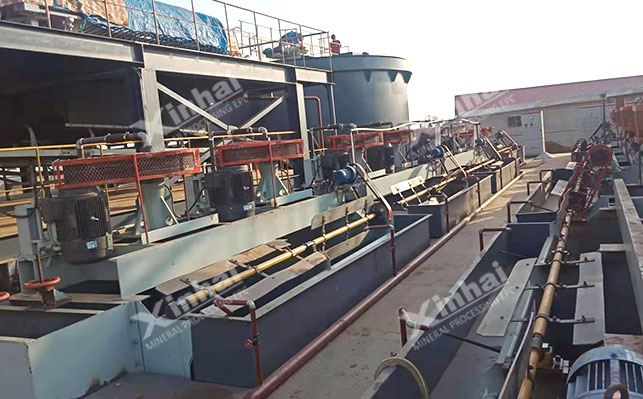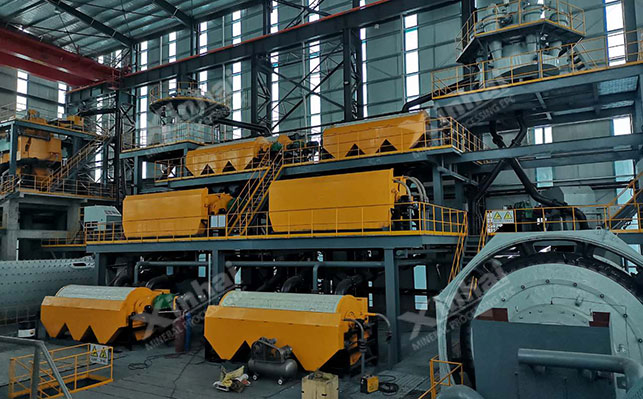Molybdenum in molybdenum tailings mainly exists in minerals such as molybdenite, calcium molybdate, and molybdenite. Most studies use stage grinding and flotation methods, using conventional flotation reagents for recovery. There are several common recycling methods:
(1) Priority flotation
The process conditions of the priority flotation process are easy to control, with high and stable production indicators. However, compared with mixed flotation, the priority flotation process has a longer flotation time, more flotation machines are used, and the grinding requirements in the early stage of flotation are high, which increases the grinding cost. In addition, the amount of inhibitors and activators used in priority flotation is large, resulting in higher production costs.
(2) Re selection and pre selection+flotation
Re selection and pre selection, including one rough selection, one pre selection, three scanning selection, three scanning selection, one pre refinement, and four heating selection for the re selected concentrate.
The rejection rate of re selection and pre selection is relatively high, reducing the cost of subsequent heating; The cost of mineral processing is relatively high; Mo and WO3 in the concentrate were not further separated.
(3) Stage grinding+stage flotation
About 88% of molybdenum in a certain molybdenum tailings exists in the form of molybdenum sulfide, which has certain recovery value. By adopting a coarse selection method of one coarse, one fine, and two sweeps, followed by four rounds of selection after grinding the coarse concentrate, molybdenum is first extracted from the tailings, and then mixed with dolomite to produce silicon fertilizer, the rational utilization of the tailings is achieved.

Tungsten in molybdenum tailings is mainly recovered through flotation, which can be divided into room temperature flotation and heated flotation. The energy consumption of room temperature flotation is low, but the quality of the obtained product is poor, and it needs to be combined with other metallurgical processes to achieve a qualified level of product. Heating flotation has high energy consumption and is not easy to control, but it can shorten the process flow and improve the sorting effect.
(1) Weak magnetic separation for iron removal+mixed flotation
For molybdenum tailings with higher alumina content and finer particle size composition, a beneficiation process of weak magnetic separation for iron removal, one coarse, three sweeps, and one fine, heated slurry adjustment, and one coarse, two sweeps, and three fine can be adopted.
Compared to priority flotation, mixed flotation has a shorter process and lower investment; The pharmaceutical system is complex and difficult to manage.
(2) Flotation desulfurization+heated flotation
WO3 has a lower grade and can be treated with flotation desulfurization, scheelite rough selection -1 coarse, 2 coarse, and 3 fine scans, as well as heating -3 fine and 2 fine scans.
The tailings have low grade and good recovery indicators; Effective separation of scheelite and gangue minerals has been achieved; Provided experience and reference for extracting tungsten from molybdenum tailings.
(3) Re selection+room temperature flotation
Room temperature flotation: one coarse and one sweep, re selection, coarse concentrate re grinding (-0.074 mm 80%), one coarse and two fine.
The resale rate is relatively high; Compared to the direct stage grinding stage, the flotation cost is lower; Good indicators; Room temperature flotation.
The magnetic iron ore contained in molybdenum tailings can be recovered through magnetic separation, while non magnetic copper, iron, and sulfur minerals are mainly comprehensively recovered through flotation.
The stage grinding stage flotation process can effectively improve the grade of concentrate. The tailings of a certain copper molybdenum mine were treated using the process route of copper molybdenum mixed selection copper molybdenum separation, and good recovery indicators were achieved.
Magnetic iron ore in molybdenum tailings can be comprehensively recovered through a combination of stage grinding and magnetic separation. When recovering pyrite from a certain molybdenum tailings, a sulfur concentrate with a grade of 41.21% and a recovery rate of 87.68% was obtained through a one coarse, one fine, and one sweep process; The final iron concentrate with a grade of 62.72% and a recovery rate of 41.86% was obtained by using the magnetic separation grinding re magnetic separation process.

(1) Recovery of feldspar
Traditional feldspar recovery mainly adopts acid flotation process, with pH controlled at 2-3, which poses a dangerous operating environment and high production costs. Acid flotation process is gradually being replaced by alkaline flotation process. The combined process of magnetic separation and flotation can effectively remove magnetic iron minerals from tailings and obtain feldspar concentrate that meets industry standards. In addition, reverse flotation technology can also be used to recover feldspar from molybdenum tailings.
(2) Recovery of Quartz
The recovery of quartz from molybdenum tailings mainly adopts flotation method, but obtaining high-quality quartz requires a longer process. The commonly used process flow includes screening, classification, magnetic separation, two-stage flotation, acid separation process flow, etc.
(3) Recycling of calcite and dolomite
Calcite and dolomite are mainly recovered through a combined process of magnetic separation flotation. After being recovered as products together, they can be used as reinforcing agents for ceramic materials to improve their performance.
(4) Recycling of mica
The recovery of mica from molybdenum tailings mainly adopts flotation method, which can be combined with other metallurgical processes to form a targeted comprehensive recovery and utilization method.
In summary, the recovery methods for valuable metal minerals such as molybdenum, tungsten, copper, iron, and sulfur in molybdenum tailings often use flotation, while the recovery methods for magnetic minerals often use magnetic separation. With the increasing particle size of mineral mining in the future, there will be fewer and fewer available raw ores, and the value of molybdenum tailings will become higher. How to fully recover valuable minerals from molybdenum tailings and make full use of them will be a greater challenge for the future!